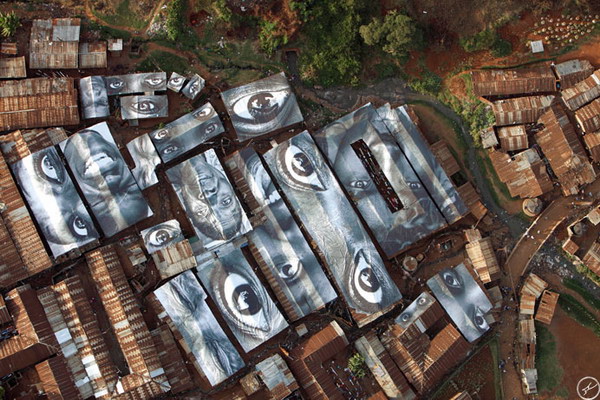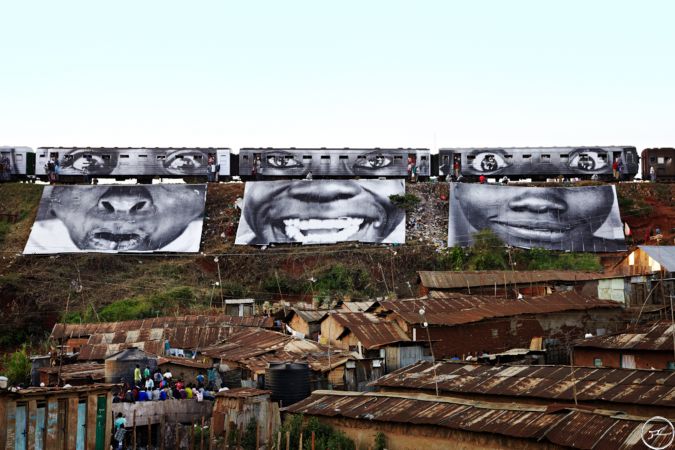
‘I think the community can benefit from what we’re doing. It didn’t feel like they cared about the art. They have nowhere to pee, they don’t know where food is coming from. That’s their problem’- Julia Neumann- Kibera Project’s Creative Director, Deutsch Agency.
Until this month, I had no idea of the beautiful art pieces that lay on the rooftops of the shanties at Kibera- the largest slum in Nairobi, the largest urban slum in Africa and which now forms the subject of the latest record of art theft in Africa.
The story of art in Kibera began in 2009 when a French artist, JR, undertook a project dubbed ‘Women are heroes’ in which he photographed the faces and eyes of women of Kibera, printed them on to vinyl- covered tarpaulins, making them water resistant and useful as a cover for the leaking roofs of Kibera. This art, for lack of a better word, is simply beautiful!

This blogger wishes she had a chance to view this beauty right at the heart of Kenya’s capital. It is a wish because, Deutsch Agency, a US advertising agency has stolen some and plans to continue stealing these art pieces under the guise of an advert named ‘Art heist for good’ in which the stolen art will be sold and the proceeds given to an NGO, Water is Life, for use in a project that entails:
1. Installing a 5000 gallon per day water filter in Kibera.
2. Building a permanent community hand washing station.
3. Repairing 40+ hand washing outlets for 4000+ school children.
4. Training Kibera women on hygiene education community programme.
5. Hygiene education incorporated in Kibera school curriculum.
6. Repairing water distribution points.
While this appears to be a taking from the poor to give to the poor venture, it brings into question a few issues: Are we back to the historical looting of Africa’s cultural treasures- only now with sugarcoated reasons? How much do Kenyans value art as Intellectual Property? How much Intellectual Property awareness is being done by the bodies charged with that responsibility? Bearing in mind that there is a long documented history of looted art in Africa and the famous kigango in Kenya, are we vulnerable as a country to preying westerners who see the value of the art that we don’t ordinarily see?
Note that the advert of this venture starts as follows:
‘..there are millions of dollars worth of unguarded art in one of the worst places in the world. I’m gonna take it, sell it to the highest bidder, and then use the money for good…’
The reference to Kibera as one of the worst places in the world is offensive, disrespectful and unmerited.
However, the central issue here is how much Kenyans value art as intellectual property. The Kenyan Intellectual property regime offers protection for artistic works under Section 22 of the Copyright Act, 2001. Artistic work includes paintings, drawings, etchings, lithographs, woodcuts, engravings and prints; maps, plans and diagrams; photographs; works of architecture in the form of buildings or models, and works of artistic craftsmanship, pictorial woven tissues and articles of applied handicraft and industrial art.
Copyright accrues to an author of artistic works automatically as long as the work is original and in a tangible/material form; meaning that lack of formal registration will not bar a claim of infringement from the author. Photographs are copyright protected for 50 years while other artistic works are protected for 50 years of the life of the author plus 50 more years after the end of the year in which the author dies.
From this, it is clear that the act of removing art pieces from Kibera and selling them constitutes infringement as the consent of the author was not sought. So far, one of the art pieces has been sold for USD 10,000 and JR, the brains behind the art pieces is reported to have said that the sold art work was a photograph taken by one of the local kids at Kibera.
It is apparent that the end users of the intellectual property regime in Kenya are not benefiting from it and clear that the people of Kibera have no clue that they have millions covering their heads. The Deutsch Agency has taken advantage to ‘benefit the community’ and to avoid the waste of such art as some of it is now damaged and used as floor coverings.
While I condemn the conniving acts of the agency, it is also true that we need to value intellectual property- lest we will continue to fall prey to onlookers on the other side of the world!